You probably have a great stash of wool. Dozens of precious yarn balls are waiting for a project. Yarn balls so special that you can only admire them without actually knitting them, waiting for their ideal destination. Yarn balls that remind you of that fair you attended and in which you had such a good time. That skein that you bought during that trip of which you keep such good memories. That skein that your friend that you met during that KAL gave you. That skein...
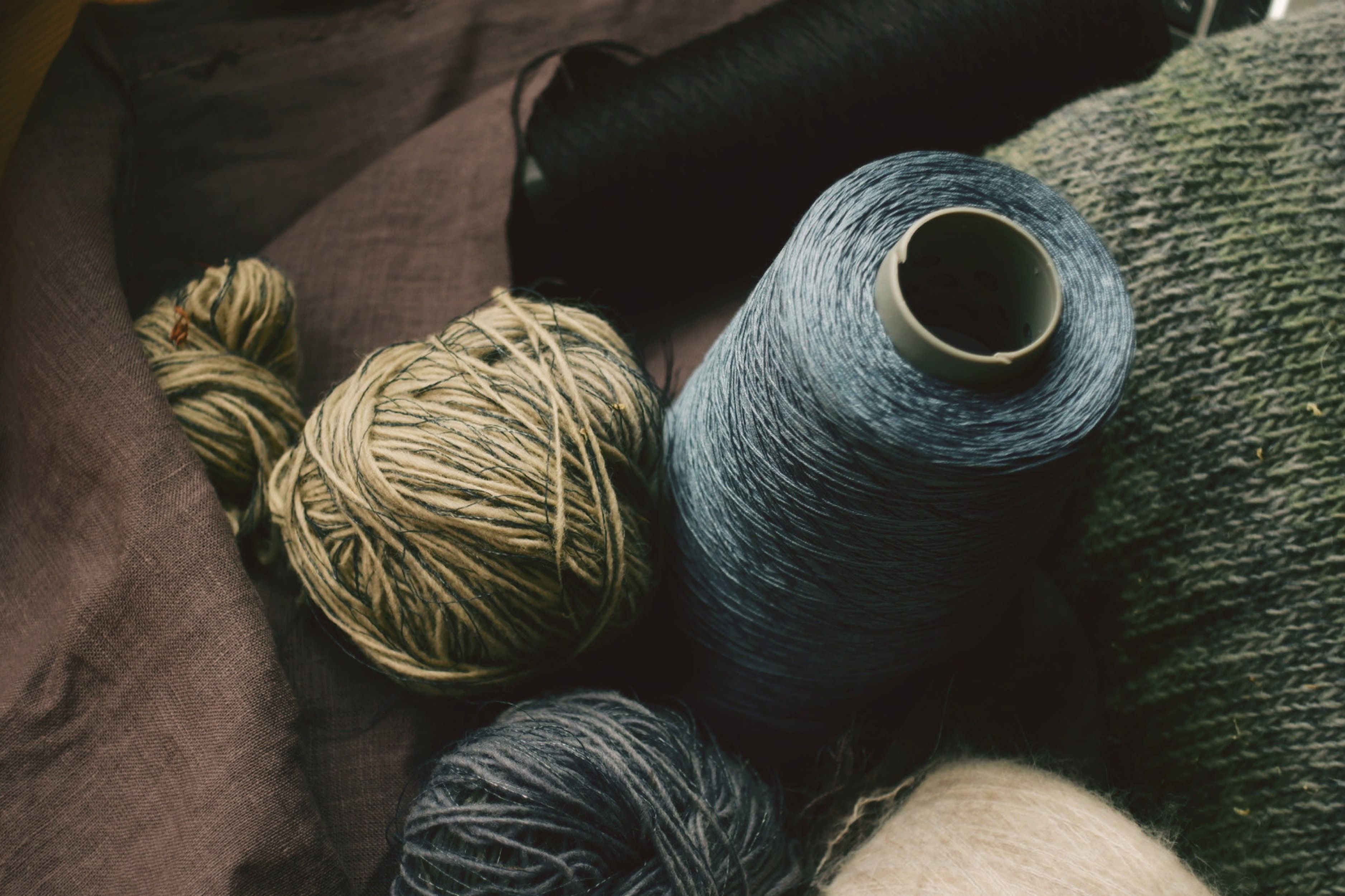 |
| Picture by Anna Auza at Unsplash |
All of us who knit and love wool know that there is more than a compulsive need to buy and pile yarn to knit sweaters, shawls, and socks behind our stash. Our skeins are memories and illusions. As are the garments we knit, with our own hands, our love, our experiences, or the memories of who made them and gave them to us.
So when the threat of the moth looms at home, we sweat, and our stomach twists. It is not just material. It is not just clothes. It is not just wool. It is a cache of memories and emotions, and it is not so easy to throw away a holey sweater or a skein that frays when there is a piece of our heart in it.
So, let's fight the moth. First step: know the enemy.
What are moths?
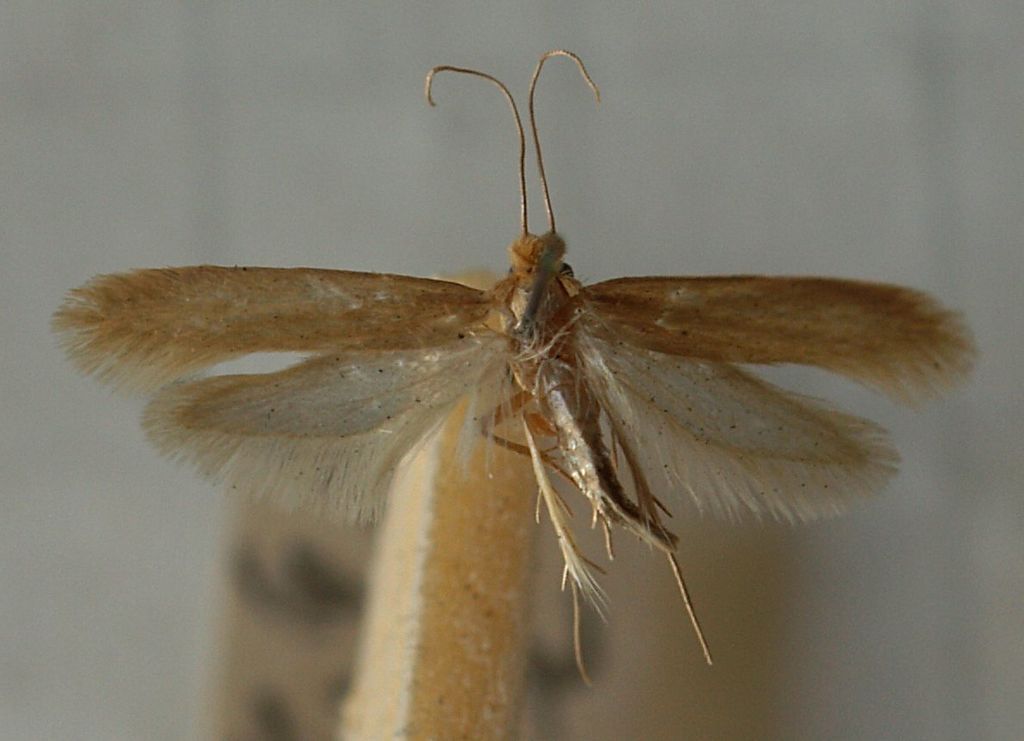 |
| Sarefo / CC BY-SA |
There are lots of moths, but the ones that have to worry us for our stash and knitted garments are the Tineola bisselliella, popularly known as the clothes moth.
This is a small butterfly less than 1 cm long, with thin and long wings covered in beige little hairs. Without patterns, its wings are reddish on the top part (a distinctive trait from other moths) and gray on the back.
Unlike the grain or food moths that can be seen flitting around the kitchen, clothes moths are more difficult to detect. Do you know the expression "like moths to a candle"? It does not apply to them. They like dark and damp spaces, lofts and basements, closed cupboards and drawers and will avoid flying in daylight.
To get you out of doubts definitely, we will explain to you a few things about the food moth, very common in houses and probably the one that is scaring you right now... "may it be a yarn-eating moth?"
Food moth (flour moth, grain moth, Indian moth, nuts moth,... however you call it: the moth that you usually find in your pantry) can be easily distinguished from the clothes moth because its colors are inverse: it is light on the top part and dark with shaded stripes on the back wings.
Plodia interpunctella (scientific name of the food moth, so you can search for her best profiles in Internet pictures and compare with the one you saw at home) eats products from vegetable origin, like cereals, flour, bread, rice, nuts... and larvae. So if you see it flying at home, you can relax... at least for your clothes and wool.
Why are clothes moths a problem?
.jpg) |
| Ilia Ustyantsev from Russia / CC BY-SA |
Contrary to popular belief, clothes moths do not eat clothes.
If you happen to see a moth fly around your house, you shouldn't worry about it if it is hungry for wool. You have to worry that a female can lay about 40-50 eggs in one sitting.
When these pinhead-sized eggs go through their larval stage, they feed on the environment in which they have been laid to grow. For this reason, the preferred place for moths to lay their eggs are surfaces high in keratin, a protein fiber easily digested by the larvae. And what are the materials rich in keratin? Wool, silk, fur, feathers,... animal fibers.
Does it mean that your mostly cotton, linen, and synthetic yarns stash is safe from moths? If the infestation is large, there is a wool blend, or we are talking about a sweater that you have kept unwashed after wearing it (and therefore among its fibers there are your own body oils and fats, food stains, etc...)... free buffet for moths!
So, finding holes in our garments or skeins that fray may be because a moth nested in our home. And if 50 eggs hatch from a moth... if we don't stop it in time, we'll soon run out of stash.
How to prevent moths?
As we have already seen, moths do not like light neither ventilated spaces, and they will not feel comfortable in such places to lay their eggs; that is what we really want to prevent. So it would be convenient to move our stash often and have it in a sunny room that we can ventilate.
In the case of clothes, we have to air them out. If we haven't worn it in a long time: unfold it (moths loves to lay their eggs in folds and seams), hang it in the sun,... and above all, if we are going to store it for a long period of time (it arrives summer and we will not wear the merino wool sweater for 6 months), wash it and let it dry well before putting it away.
If you have carpets, it is essential to vacuum them frequently because they are ideal for larvae to grow up.
If we have pets, especially caged birds, it is better that they are not near the stash (in nature, larvae mainly grow in nests, feeding on feathers, bird carcasses, and other critters).
Moths do not like strong smells, so put sachets with spices (cloves, pepper, cinnamon,...), aromatic plants (bay leaves, lavender,...), or citrus (dried lemon zest and orange slices) can scare them away.
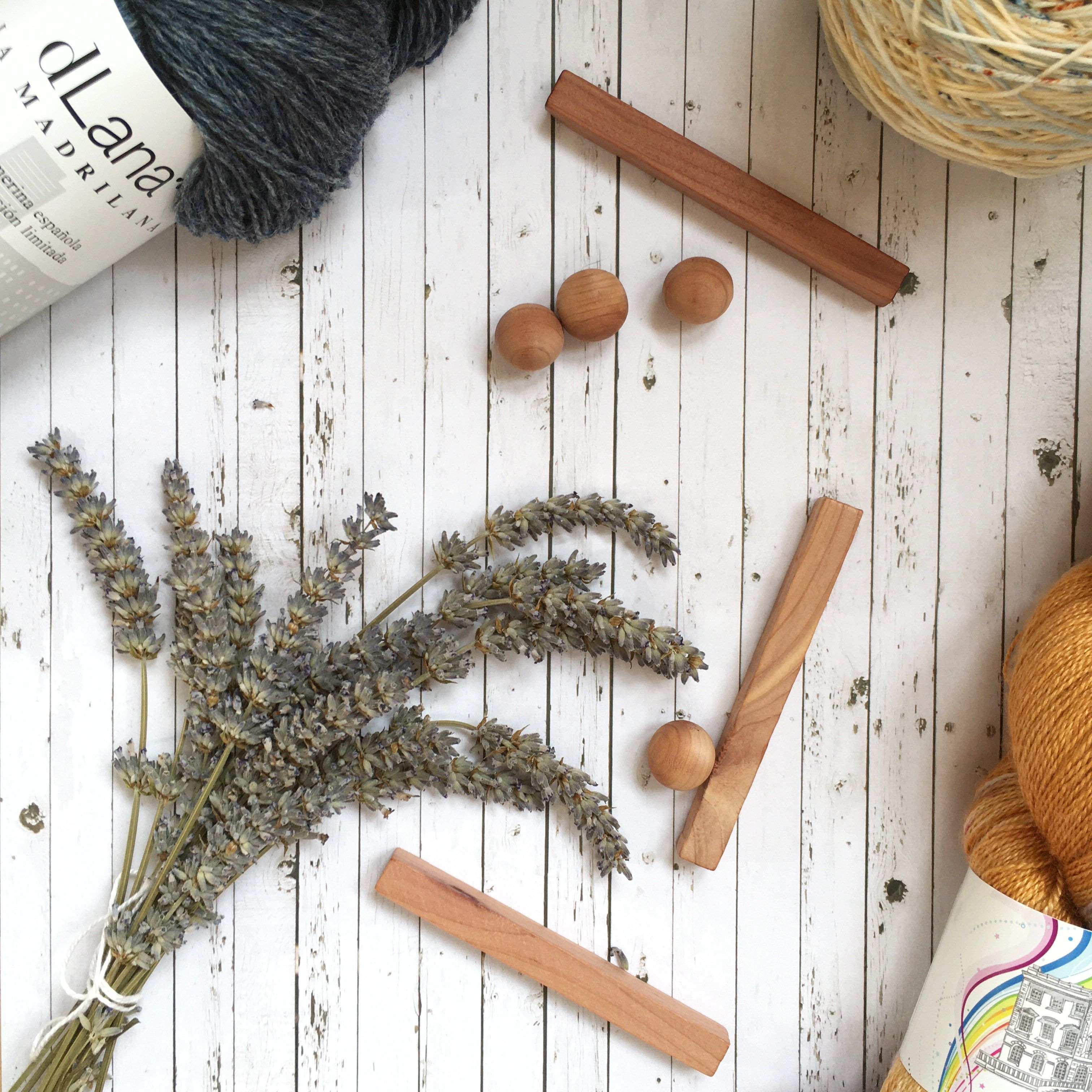 |
The use of cedarwood is also interesting. It would be ideal to keep our wool in a cedar wood closet hermetically, but we can put sticks or wooden balls in our stash in the absence of it. The smell of these pieces of wood loses intensity and, therefore, effectiveness over time. A good trick is to run a bit of sandpaper over the surface to reach lower layers that still have the oils that give off this smell.
In the same way, you can soak some cotton balls with essential oil of cedar, lavender, clove, or citrus and spread them over the stash. You should change these cotton from time to time when you notice that they are losing intensity.
Another thing that you can do is to put moth traps near your stash. These traps (cardboard covered in a kind of glue with artificial pheromones) are marketed for food moths, but if you have hung one in your pantry, you have surely found more than one bug attached to it. It is not a repellent for moths itself, but it helps us control how much population there is in the area and know if we can be more or less calm. Besides, the pheromone in the trap attracts males, preventing female moths from being fertilized and, therefore, from larvae being a problem.
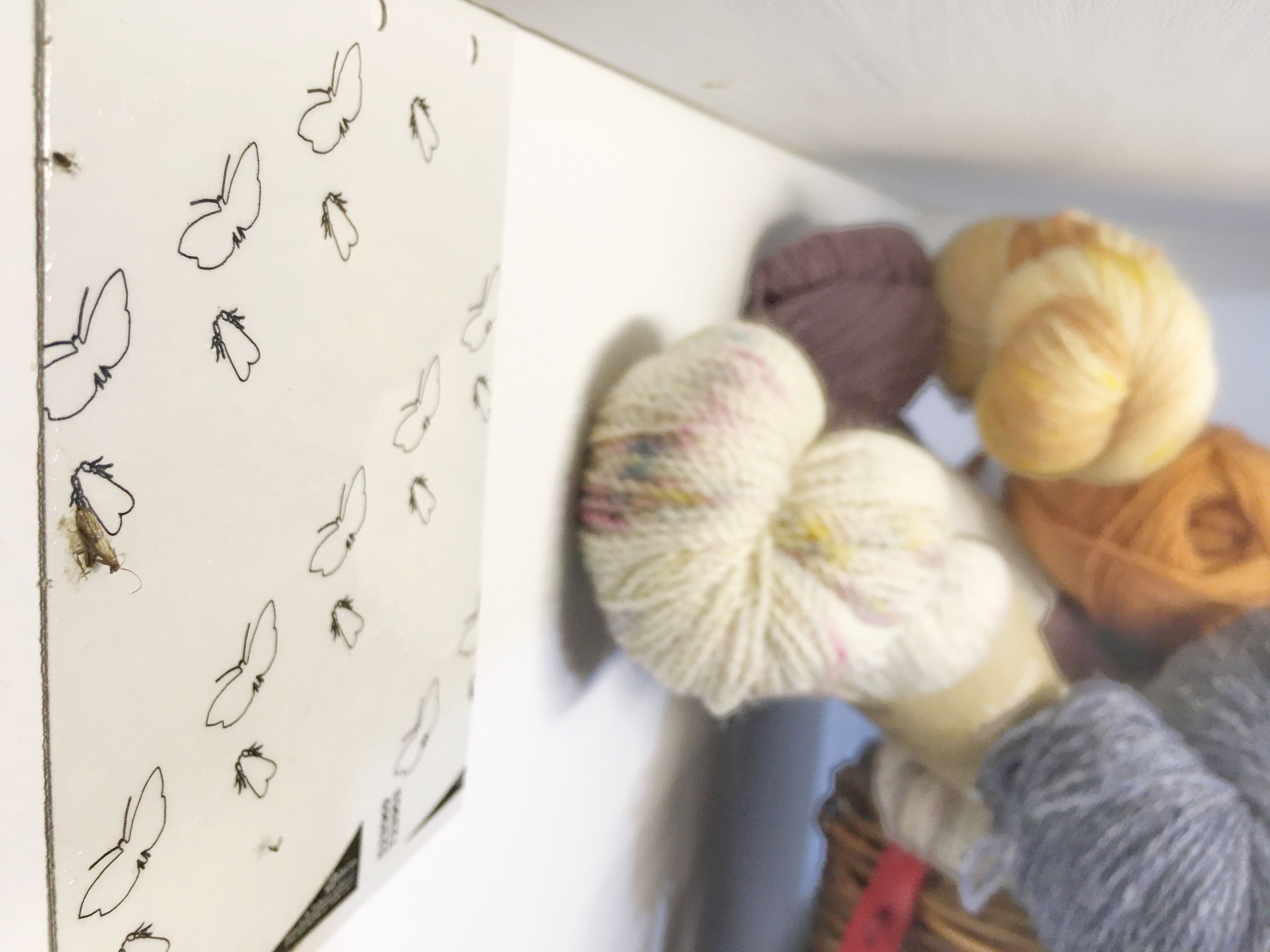 |
In summary, it is not a clothes moth trap, but you can gain some peace of mind.
Remember that all these resources are only to prevent the moth from approaching, to make it uncomfortable near your stash to lay its eggs. Neither spices, lavender, nor cedar balls will kill the moth or have any effect on the larvae: if the laying of eggs has already been done, none of this is going to prevent larvae from feeding on your stash.
At this point, if your stress levels are already through the roof and you don't have enough confidence in the olfactory scarers power... store your skeins tightly in plastic bags. If you are totally sure that there are no larvae, once the yarn is wrapped in plastic, moths will have no chance to enter there.
Other repellants (which can also repel you) are camphor, mothballs (be careful with children and pets, due to its toxicity), permethrin,... and other synthetic insecticides that we hope you don't have to use. In this case, we are talking about toxic resources that can kill the moth, but in the case of the larvae (what must really concern us), the product has to come into direct contact with it to kill it, and the application will not be as easy as spraying the yarn.
If you are at the point that you consider using these products, better contact a professional fumigation service.
Too late: there are moths in my stash!
Before setting the house on fire, take a deep breath, and let's see what we can save.
You may have seen and correctly identified a clothes moth, but it may not have had time to lay eggs yet, or they may not have started to hatch into larvae.
Check your clothes and stash for tiny sticky pellets: the eggs.
If larvae have started feeding, you will identify small holes in the tissue, surrounded by grit (larva faeces) stuck to the tissue.
Take the garment outside and brush it vigorously. This will pop out any eggs and larvae that are still attached to the clothing. Air it out and let it under the sun before washing it.
Dry cleaning will kill larvae that are still attached to clothing.
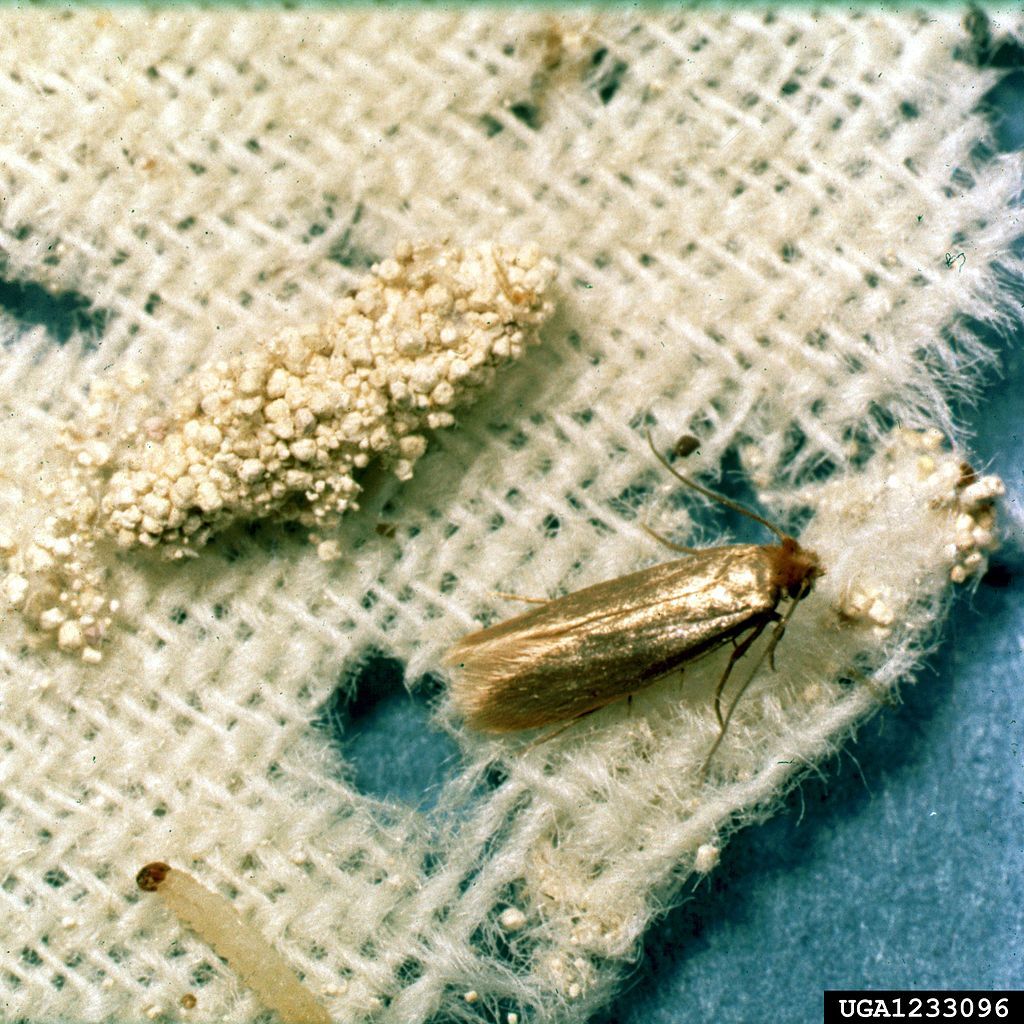 |
| Clemson University - USDA Cooperative Extension Slide Series, Bugwood.org / CC BY 3.0 US |
In the case of skeins and yarn balls, you can put them in the freezer for a few days, better if it can be weeks. Intense cold kills the larvae... but not the eggs, which can survive the freezing process.
High temperatures also kill the eggs... but putting the wool to a boil doesn't look a great idea, right? You can leave it in a closed container in full sun in summer.
Be it cold or heat, once the process is over, shake well and, if possible, vacuum or make sure that there are no remains. Empty the vacuum cleaner's contents in a plastic bag, close it well, and do not leave it inside the house. Get rid of it as quickly as possible.
Once you have shed the eggs and larvae attached to clothing and wool, you can wash them, let them dry completely, and put them back in closed plastic containers. Before putting wool or clothing back into storage, ventilate, vacuum, and clean the room well.
In any case, killing the larvae or getting rid of the eggs will have prevented further damage, but what if the damage was already done?
If the larva has already turned into a moth, possibly the only remnant you will find on your clothing is a huge hole, or you will have a skein with several loose ends. Do you have to throw away the sweater? And now, what do you do with a skein with an unstable or broken thread?
In the case of clothing, you can go for a strategy that is becoming fashionable again and that is going to give your clothes a new life: mending. You can imitate the knit stitch and replicate the fabric (swiss darning), or you can apply embroideries to repair and embellish at the same time.
In the case of skeins, if they are 100% wool, you can rejoin the ends with wet felting. In wools with superwash treatment or other types of fibers, you can try other kinds of invisible joints, such as the ones we explained in this post.
We hope you never have to get to this point and that this article has been useful to you in time.
